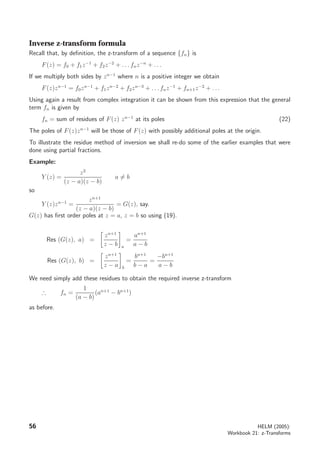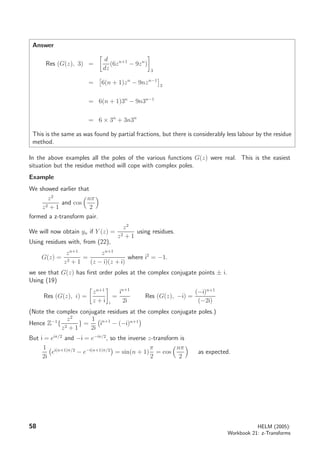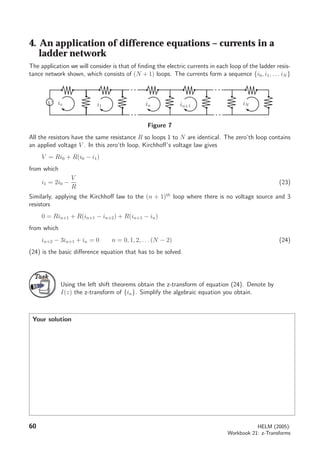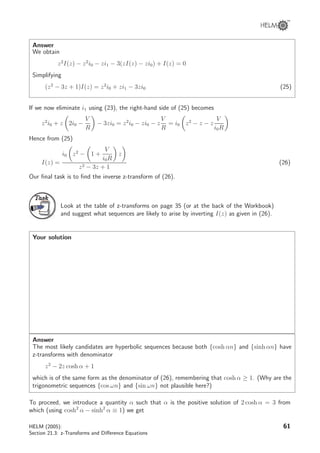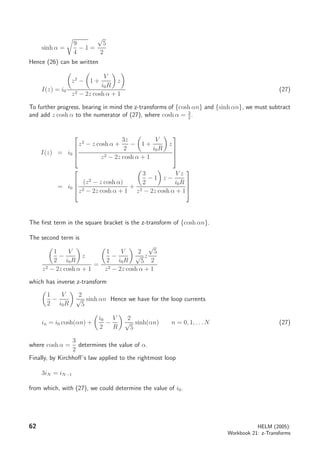The document discusses using z-transforms to solve difference equations. It provides examples of first and second order linear difference equations and explains how to solve them using z-transforms. The process involves taking the z-transform of each term in the difference equation, resulting in an algebraic equation that can be solved for the z-transform of the solution sequence. The inverse z-transform is then found to obtain the solution sequence. Partial fractions and residues can be used to invert z-transforms.

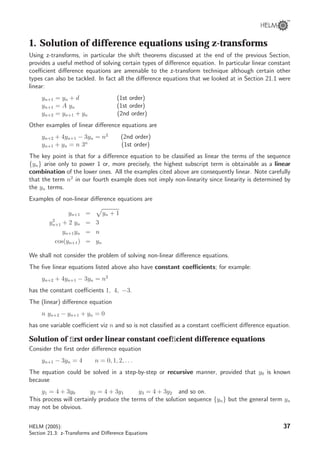
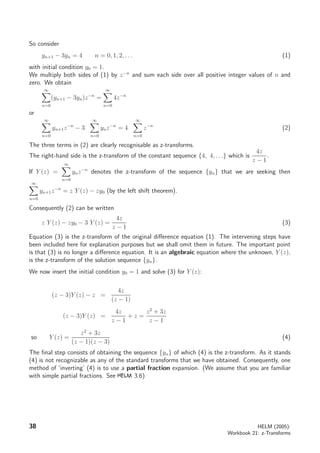
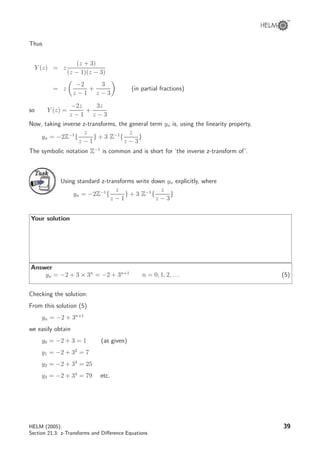


![Answer
(z − 1)Y (z) =
d × z
(z − 1)
+ z × a
Y (z) =
d × z
(z − 1)2
+
a × z
z − 1
Finally take the inverse z-transform of the right-hand side. [Hint: Recall the z-transform of the ramp
sequence {n}.]
Your solution
Answer
We have
yn = d × Z−1
{
z
(z − 1)2
} + a × Z−1
{
z
z − 1
}
∴ yn = dn + a n = 0, 1, 2, . . . (7)
using the known z-transforms of the ramp and unit step sequences. Equation (7) may well be a
familiar result to you – an arithmetic sequence whose ‘zeroth’ term is y0 = a has general term
yn = a + nd.
i.e. {yn} = {a, a + d, . . . a + nd, . . .}
This solution is of course readily obtained by direct recursive solution of (6) without need for z-
transforms. In this case the general term (a + nd) is readily seen from the form of the recursive
solution: (Make sure you really do see it).
N.B. If the term a is labelled as the first term (rather than the zeroth) then
y1 = a, y2 = a + d, y3 − a + 2d,
so in this case the n th
term is
yn = a + (n − 1)d
rather than (7).
42 HELM (2005):
Workbook 21: z-Transforms](https://image.slidesharecdn.com/213-150202114919-conversion-gate02/85/21-3-ztransform-7-320.jpg)
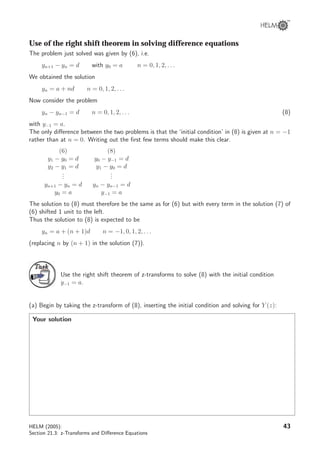
![Answer
We have, for the z-transform of (8)
Y (z) − (z−1
Y (z) + y−1) =
dz
z − 1
[Note that here dz means d × z]
Y (z)(1 − z−1
) − a =
dz
z − 1
Y (z)
z − 1
z
=
dz
(z − 1)
+ a
Y (z) =
dz2
(z − 1)2
+
az
z − 1
(9)
The second term of Y (z) has the inverse z-transform {a un} = {a, a, a, . . .}.
The first term is less straightforward. However, we have already reasoned that the other term in yn
here should be (n + 1)d.
(b) Show that the z-transform of (n + 1)d is
dz2
(z − 1)2
. Use the standard transform of the ramp and
step:
Your solution
Answer
We have
Z{(n + 1)d} = dZ{n} + dZ{1}
by the linearity property
∴ Z{(n + 1)d} =
dz
(z − 1)2
+
dz
z − 1
= dz
1 + z − 1
(z − 1)2
=
dz2
(z − 1)2
as expected.
44 HELM (2005):
Workbook 21: z-Transforms](https://image.slidesharecdn.com/213-150202114919-conversion-gate02/85/21-3-ztransform-9-320.jpg)




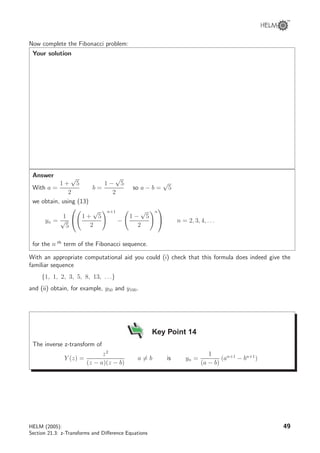
![TaskTask
Use the right shift property of z-transforms to solve the second order difference
equation
yn − 7yn−1 + 10 yn−2 = 0 with y−1 = 16 and y−2 = 5.
[Hint: the steps involved are the same as in the previous Task]
Your solution
Answer
Y (z) − 7(z−1
Y (z) + 16) + 10(z−2
Y (z) + 16z−1
+ 5) = 0
Y (z)(1 − 7z−1
+ 10z−2
) − 112 + 160z−1
+ 50 = 0
Y (z)
z2
− 7z + 10
z2
= 62 − 160z−1
Y (z) =
62z2
z2 − 7z + 10
−
160z
z2 − 7z + 10
= z
(62z − 160)
(z − 2)(z − 5)
=
12z
z − 2
+
50z
z − 5
in partial fractions
so yn = 12 × 2n
+ 50 × 5n
n = 0, 1, 2, . . .
We now give an Example where a quadratic equation with repeated solutions arises.
50 HELM (2005):
Workbook 21: z-Transforms](https://image.slidesharecdn.com/213-150202114919-conversion-gate02/85/21-3-ztransform-15-320.jpg)
![Example 1
(a) Obtain the z-transform of {fn} = {nan
}.
(b) Solve
yn − 6yn−1 + 9yn−2 = 0 n = 0, 1, 2, . . .
y−1 = 1 y−2 = 0
[Hint: use the result from (a) at the inversion stage.]
Solution
(a) Z{n} =
z
(z − 1)2
∴ Z{nan
} =
z/a
(z/a − 1)2 =
az
(z − a)2
where we have used the
property Z{fn an
} = F
z
a
(b) Taking the z-transform of the difference equation and inserting the initial conditions:
Y (z) − 6(z−1
Y (z) + 1) + 9(z−2
Y (z) + z−1
) = 0
Y (z)(1 − 6z−1
+ 9z−2
) = 6 − 9z−1
Y (z)(z2
− 6z + 9) = 6z2
− 9z
Y (z) =
6z2
− 9z
(z − 3)2
= z
6z − 9
(z − 3)2
= z
6
z − 3
+
9
(z − 3)2
in partial fractions
from which, using the result (a) on the second term,
yn = 6 × 3n
+ 3n × 3n
= (6 + 3n)3n
We shall re-do this inversion by an alternative method shortly.
TaskTask
Solve the difference equation
yn+2 + yn = 0 with y0, y1 arbitrary. (14)
Start by obtaining Y (z) using the left shift theorem:
Your solution
HELM (2005):
Section 21.3: z-Transforms and Difference Equations
51](https://image.slidesharecdn.com/213-150202114919-conversion-gate02/85/21-3-ztransform-16-320.jpg)


![Residue at a pole
The residue of a complex function G(z) at a first order pole z0 is
Res (G(z), z0) = [G(z)(z − z0)]z0
(19)
The residue at a second order pole z0 is
Res (G(z), z0) =
d
dz
(G(z)(z − z0)2
)
z0
(20)
You need not worry about how these results are obtained or their full mathematical significance.
(Any textbook on Complex Variable Theory could be consulted by interested readers.)
Example
Consider again the function (18) in the previous guided exercise.
G(z) =
3(z + 4)
z2(2z + 1)(3z − 9)
=
(z + 4)
2z2 z + 1
2
(z − 3)
The second form is the more convenient for the residue formulae to be used.
Using (19) at the two first order poles:
Res G(z), −
1
2
= G(z) z − −
1
2 1
2
=
(z + 4)
2z2(z − 3) 1
2
= −
18
5
Res [G(z), 3] =
(z + 4)
2z2 z +
1
2
3
=
1
9
Using (20) at the second order pole
Res (G(z), 0) =
d
dz
(G(z)(z − 0)2
)
0
The differentiation has to be carried out before the substitution of z = 0 of course.
∴ Res (G(z), 0) =
d
dz
(z + 4)
2 z +
1
2
(z − 3)
0
=
1
2
d
dz
z + 4
z2 −
5
2
z −
3
2
0
54 HELM (2005):
Workbook 21: z-Transforms](https://image.slidesharecdn.com/213-150202114919-conversion-gate02/85/21-3-ztransform-19-320.jpg)

